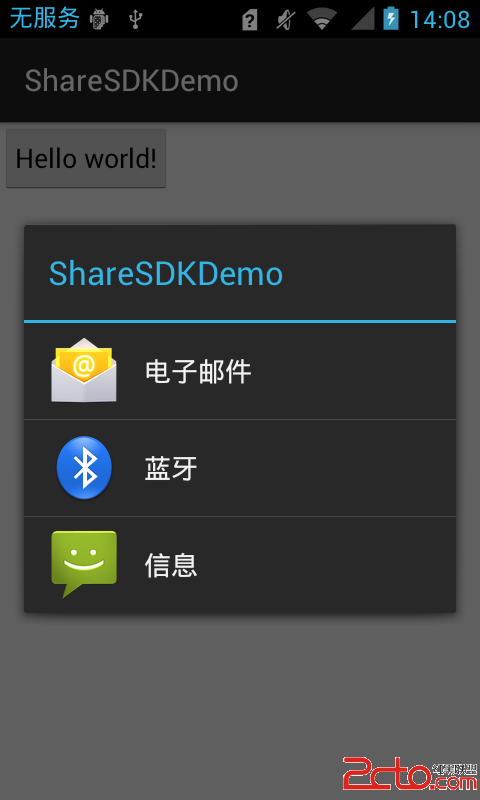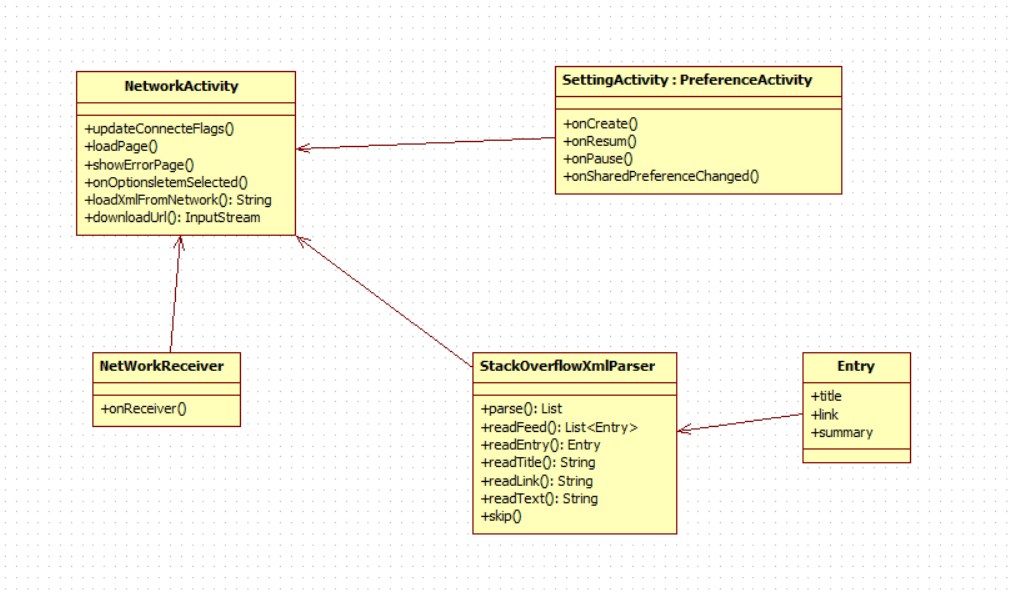編輯:關於Android編程
前面文章講解了Android的藍牙基本用法,本文講得深入些,探討下藍牙方面的隱藏API。用過Android系統設置(Setting)的人都知道藍牙搜索之後可以建立配對和解除配對,但是這兩項功能的函數沒有在SDK中給出,那麼如何去使用這兩項功能呢?本文利用JAVA的反射機制去調用這兩項功能對應的函數:createBond和removeBond,具體的發掘和實現步驟如下:
1.使用Git工具下載platform/packages/apps/Settings.git,在Setting源碼中查找關於建立配對和解除配對的API,知道這兩個API的宿主(BluetoothDevice);
2.使用反射機制對BluetoothDevice枚舉其所有方法和常量,看看是否存在:
static public void printAllInform(Class clsShow) {
try {
// 取得所有方法
Method[] hideMethod = clsShow.getMethods();
int i = 0;
for (; i < hideMethod.length; i++) {
Log.e("method name", hideMethod[i].getName());
}
// 取得所有常量
Field[] allFields = clsShow.getFields();
for (i = 0; i < allFields.length; i++) {
Log.e("Field name", allFields[i].getName());
}
} catch (SecurityException e) {
// throw new RuntimeException(e.getMessage());
e.printStackTrace();
} catch (IllegalArgumentException e) {
// throw new RuntimeException(e.getMessage());
e.printStackTrace();
} catch (Exception e) {
// TODO Auto-generated catch block
e.printStackTrace();
}
}
結果如下:
11-29 09:19:12.012: method name(452): cancelBondProcess
11-29 09:19:12.020: method name(452): cancelPairingUserInput
11-29 09:19:12.020: method name(452): createBond
11-29 09:19:12.020: method name(452): createInsecureRfcommSocket
11-29 09:19:12.027: method name(452): createRfcommSocket
11-29 09:19:12.027: method name(452): createRfcommSocketToServiceRecord
11-29 09:19:12.027: method name(452): createScoSocket
11-29 09:19:12.027: method name(452): describeContents
11-29 09:19:12.035: method name(452): equals
11-29 09:19:12.035: method name(452): fetchUuidsWithSdp
11-29 09:19:12.035: method name(452): getAddress
11-29 09:19:12.035: method name(452): getBluetoothClass
11-29 09:19:12.043: method name(452): getBondState
11-29 09:19:12.043: method name(452): getName
11-29 09:19:12.043: method name(452): getServiceChannel
11-29 09:19:12.043: method name(452): getTrustState
11-29 09:19:12.043: method name(452): getUuids
11-29 09:19:12.043: method name(452): hashCode
11-29 09:19:12.043: method name(452): isBluetoothDock
11-29 09:19:12.043: method name(452): removeBond
11-29 09:19:12.043: method name(452): setPairingConfirmation
11-29 09:19:12.043: method name(452): setPasskey
11-29 09:19:12.043: method name(452): setPin
11-29 09:19:12.043: method name(452): setTrust
11-29 09:19:12.043: method name(452): toString
11-29 09:19:12.043: method name(452): writeToParcel
11-29 09:19:12.043: method name(452): convertPinToBytes
11-29 09:19:12.043: method name(452): getClass
11-29 09:19:12.043: method name(452): notify
11-29 09:19:12.043: method name(452): notifyAll
11-29 09:19:12.043: method name(452): wait
11-29 09:19:12.051: method name(452): wait
11-29 09:19:12.051: method name(452): wait
3.如果枚舉發現API存在(SDK卻隱藏),則自己實現調用方法:
/**
* 與設備配對 參考源碼:platform/packages/apps/Settings.git
* /Settings/src/com/android/settings/bluetooth/CachedBluetoothDevice.java
*/
static public boolean createBond(Class btClass,BluetoothDevice btDevice) throws Exception {
Method createBondMethod = btClass.getMethod("createBond");
Boolean returnValue = (Boolean) createBondMethod.invoke(btDevice);
return returnValue.booleanValue();
}
/**
* 與設備解除配對 參考源碼:platform/packages/apps/Settings.git
* /Settings/src/com/android/settings/bluetooth/CachedBluetoothDevice.java
*/
static public boolean removeBond(Class btClass,BluetoothDevice btDevice) throws Exception {
Method removeBondMethod = btClass.getMethod("removeBond");
Boolean returnValue = (Boolean) removeBondMethod.invoke(btDevice);
return returnValue.booleanValue();
}
此處注意:SDK之所以不給出隱藏的API肯定有其原因,也許是出於安全性或者是後續版本兼容性的考慮,因此不能保證隱藏API能在所有Android平台上很好地運行。
本文程序運行效果如下圖所示:

main.xml源碼如下:
<?xml version="1.0" encoding="utf-8"?> <LinearLayout xmlns:android="http://schemas.android.com/apk/res/android" android:orientation="vertical" android:layout_width="fill_parent" android:layout_height="fill_parent"> <LinearLayout android:id="@+id/LinearLayout01" android:layout_height="wrap_content" android:layout_width="fill_parent"> <Button android:layout_height="wrap_content" android:id="@+id/btnSearch" android:text="Search" android:layout_width="160dip"></Button> <Button android:layout_height="wrap_content" android:layout_width="160dip" android:text="Show" android:id="@+id/btnShow"></Button> </LinearLayout> <LinearLayout android:id="@+id/LinearLayout02" android:layout_width="wrap_content" android:layout_height="wrap_content"></LinearLayout> <ListView android:id="@+id/ListView01" android:layout_width="fill_parent" android:layout_height="fill_parent"> </ListView> </LinearLayout>
工具類ClsUtils.java源碼如下:
package com.testReflect;
import java.lang.reflect.Field;
import java.lang.reflect.Method;
import android.bluetooth.BluetoothDevice;
import android.util.Log;
public class ClsUtils {
/**
* 與設備配對 參考源碼:platform/packages/apps/Settings.git
* /Settings/src/com/android/settings/bluetooth/CachedBluetoothDevice.java
*/
static public boolean createBond(Class btClass,BluetoothDevice btDevice) throws Exception {
Method createBondMethod = btClass.getMethod("createBond");
Boolean returnValue = (Boolean) createBondMethod.invoke(btDevice);
return returnValue.booleanValue();
}
/**
* 與設備解除配對 參考源碼:platform/packages/apps/Settings.git
* /Settings/src/com/android/settings/bluetooth/CachedBluetoothDevice.java
*/
static public boolean removeBond(Class btClass,BluetoothDevice btDevice) throws Exception {
Method removeBondMethod = btClass.getMethod("removeBond");
Boolean returnValue = (Boolean) removeBondMethod.invoke(btDevice);
return returnValue.booleanValue();
}
/**
*
* @param clsShow
*/
static public void printAllInform(Class clsShow) {
try {
// 取得所有方法
Method[] hideMethod = clsShow.getMethods();
int i = 0;
for (; i < hideMethod.length; i++) {
Log.e("method name", hideMethod[i].getName());
}
// 取得所有常量
Field[] allFields = clsShow.getFields();
for (i = 0; i < allFields.length; i++) {
Log.e("Field name", allFields[i].getName());
}
} catch (SecurityException e) {
// throw new RuntimeException(e.getMessage());
e.printStackTrace();
} catch (IllegalArgumentException e) {
// throw new RuntimeException(e.getMessage());
e.printStackTrace();
} catch (Exception e) {
// TODO Auto-generated catch block
e.printStackTrace();
}
}
}
主程序testReflect.java的源碼如下:
package com.testReflect;
import java.util.ArrayList;
import java.util.List;
import android.app.Activity;
import android.bluetooth.BluetoothAdapter;
import android.bluetooth.BluetoothDevice;
import android.content.BroadcastReceiver;
import android.content.Context;
import android.content.Intent;
import android.content.IntentFilter;
import android.os.Bundle;
import android.util.Log;
import android.view.View;
import android.widget.AdapterView;
import android.widget.ArrayAdapter;
import android.widget.Button;
import android.widget.ListView;
import android.widget.Toast;
public class testReflect extends Activity {
Button btnSearch, btnShow;
ListView lvBTDevices;
ArrayAdapter<String> adtDevices;
List<String> lstDevices = new ArrayList<String>();
BluetoothDevice btDevice;
BluetoothAdapter btAdapt;
@Override
public void onCreate(Bundle savedInstanceState) {
super.onCreate(savedInstanceState);
setContentView(R.layout.main);
btnSearch = (Button) this.findViewById(R.id.btnSearch);
btnSearch.setOnClickListener(new ClickEvent());
btnShow = (Button) this.findViewById(R.id.btnShow);
btnShow.setOnClickListener(new ClickEvent());
lvBTDevices = (ListView) this.findViewById(R.id.ListView01);
adtDevices = new ArrayAdapter<String>(testReflect.this,
android.R.layout.simple_list_item_1, lstDevices);
lvBTDevices.setAdapter(adtDevices);
lvBTDevices.setOnItemClickListener(new ItemClickEvent());
btAdapt = BluetoothAdapter.getDefaultAdapter();// 初始化本機藍牙功能
if (btAdapt.getState() == BluetoothAdapter.STATE_OFF)// 開藍牙
btAdapt.enable();
// 注冊Receiver來獲取藍牙設備相關的結果
IntentFilter intent = new IntentFilter();
intent.addAction(BluetoothDevice.ACTION_FOUND);
intent.addAction(BluetoothDevice.ACTION_BOND_STATE_CHANGED);
registerReceiver(searchDevices, intent);
}
private BroadcastReceiver searchDevices = new BroadcastReceiver() {
public void onReceive(Context context, Intent intent) {
String action = intent.getAction();
Bundle b = intent.getExtras();
Object[] lstName = b.keySet().toArray();
// 顯示所有收到的消息及其細節
for (int i = 0; i < lstName.length; i++) {
String keyName = lstName[i].toString();
Log.e(keyName, String.valueOf(b.get(keyName)));
}
// 搜索設備時,取得設備的MAC地址
if (BluetoothDevice.ACTION_FOUND.equals(action)) {
BluetoothDevice device = intent
.getParcelableExtra(BluetoothDevice.EXTRA_DEVICE);
if (device.getBondState() == BluetoothDevice.BOND_NONE) {
String str = "未配對|" + device.getName() + "|" + device.getAddress();
lstDevices.add(str); // 獲取設備名稱和mac地址
adtDevices.notifyDataSetChanged();
}
}
}
};
class ItemClickEvent implements AdapterView.OnItemClickListener {
@Override
public void onItemClick(AdapterView<?> arg0, View arg1, int arg2,
long arg3) {
btAdapt.cancelDiscovery();
String str = lstDevices.get(arg2);
String[] values = str.split("//|");
String address=values[2];
btDevice = btAdapt.getRemoteDevice(address);
try {
if(values[0].equals("未配對"))
{
Toast.makeText(testReflect.this, "由未配對轉為已配對", 500).show();
ClsUtils.createBond(btDevice.getClass(), btDevice);
}
else if(values[0].equals("已配對"))
{
Toast.makeText(testReflect.this, "由已配對轉為未配對", 500).show();
ClsUtils.removeBond(btDevice.getClass(), btDevice);
}
} catch (Exception e) {
// TODO Auto-generated catch block
e.printStackTrace();
}
}
}
/**
* 按鍵處理
* @author GV
*
*/
class ClickEvent implements View.OnClickListener {
@Override
public void onClick(View v) {
if (v == btnSearch) {//搜索附近的藍牙設備
lstDevices.clear();
Object[] lstDevice = btAdapt.getBondedDevices().toArray();
for (int i = 0; i < lstDevice.length; i++) {
BluetoothDevice device=(BluetoothDevice)lstDevice[i];
String str = "已配對|" + device.getName() + "|" + device.getAddress();
lstDevices.add(str); // 獲取設備名稱和mac地址
adtDevices.notifyDataSetChanged();
}
// 開始搜索
setTitle("本機藍牙地址:" + btAdapt.getAddress());
btAdapt.startDiscovery();
}
else if(v==btnShow){//顯示BluetoothDevice的所有方法和常量,包括隱藏API
ClsUtils.printAllInform(btDevice.getClass());
}
}
}
}
希望本文實例能夠對大家進行Android程序開發有一定的借鑒幫助作用。
 Android項目總結之社會化分享
Android項目總結之社會化分享
Android項目總結之社會化分享隨著現在社交網絡的日益繁多,眾多的社交客戶端已占據了人們的大量時間,所以在我們的應用中具有一鍵分享的功能對提高我們產品的知名度有很大的幫
 React Native自定義導航欄
React Native自定義導航欄
經過之前的學習, 我們可以完成一個自定義導航欄了, 效果如下:我們需要創建一個 NaviBar.js 用來顯示頂部的導航欄, 還需要四個界面(Page1.js,Page2
 跟Google 學代碼 : Building Apps with Connectivity & the Cloud【Webapp Usage】
跟Google 學代碼 : Building Apps with Connectivity & the Cloud【Webapp Usage】
本文介紹本文是翻譯自Google 官方課程 Building Apps with Connectivity & the Cloud 第二節 Performing
 Android 三大圖片緩存原理、特性對比
Android 三大圖片緩存原理、特性對比
這是我在 MDCC 上分享的內容(略微改動),也是源碼解析第一期發布時介紹的源碼解析後續會慢慢做的事。從總體設計和原理上對幾個圖片緩存進行對比,沒用到他們的朋友也可以了解